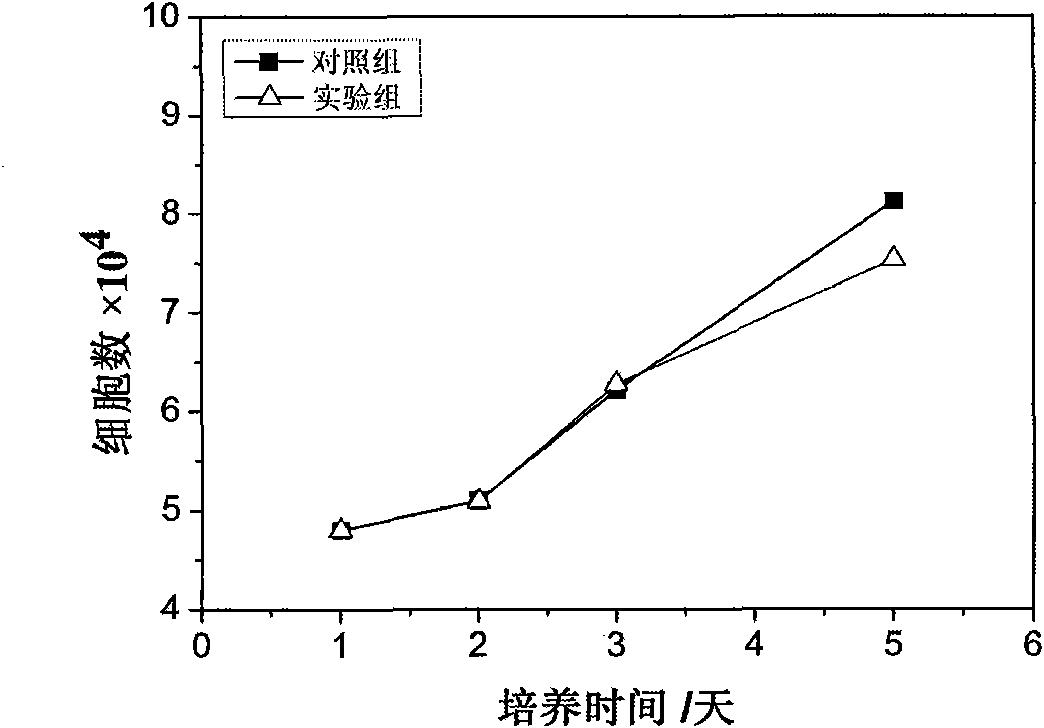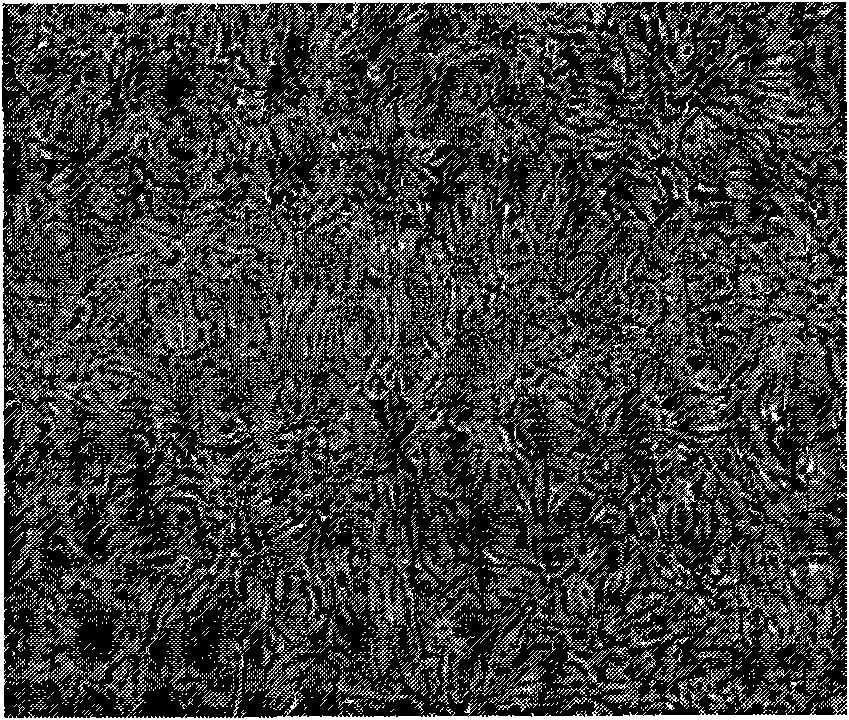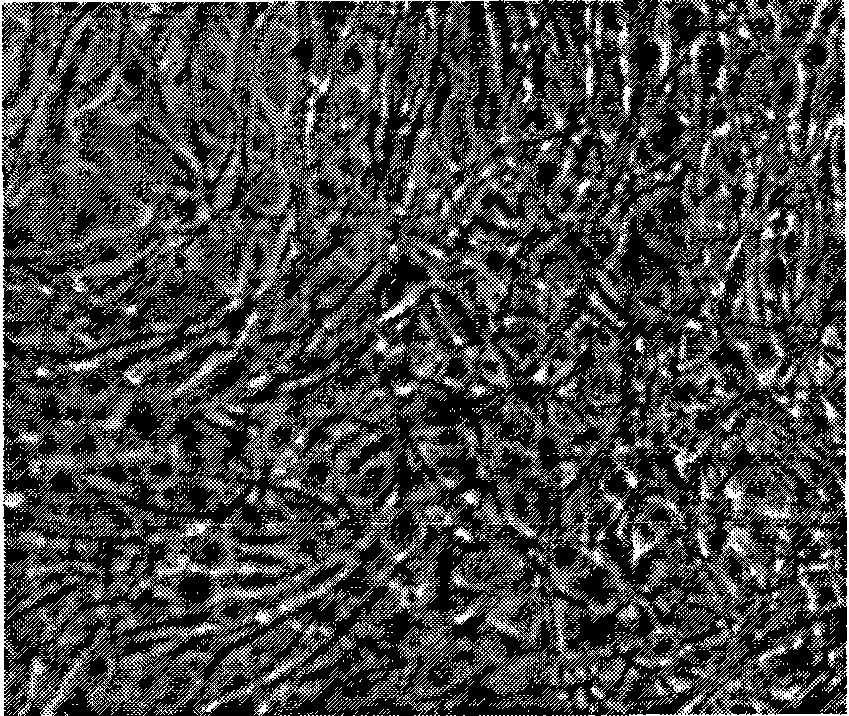Tissue engineering material-based culture method and applications of melanophore
A melanocyte and cell culture technology, applied in the field of biomedicine, can solve the problems of cell culture and biosafety, easily damaged tissue engineering epidermis, unable to meet transfer and transplantation and other problems, achieve good mechanical properties, maintain cell activity and shape good effect
- Summary
- Abstract
- Description
- Claims
- Application Information
AI Technical Summary
Problems solved by technology
Method used
Image
Examples
Embodiment 1
[0029] Embodiment 1. Preparation of chitosan-based carrier film material
[0030] a) dissolving chitosan with 1M acetic acid solution to make a chitosan solution with a concentration of 1.5%;
[0031] b) 2.5ml of chitosan solution was injected into the cell culture plate, the cell culture plate was placed in a blast oven, and dried at 50° C. for 6 hours;
[0032] c) Place the dried chitosan film in 0.5M Na 2 SO 4 Soak in the solution for 30 minutes, then rinse with plenty of pure water;
[0033] d) Soak the chitosan membrane with 0.1M NaOH solution for 30min to remove residual acetic acid on the membrane, and then wash it to pH=7.2-7.4 with a large amount of pure water;
[0034] e) placing the cell culture plate covered with the chitosan membrane in a blast oven, and drying at 37° C. for 24 hours;
[0035] f) obtaining a carrier membrane material that can be used for cell culture and transfer.
Embodiment 2
[0036] Embodiment 2. Preparation of chitosan-hyaluronic acid-based composite carrier membrane material
[0037] a) dissolving chitosan with 1M acetic acid solution to make a chitosan solution with a concentration of 1.5%;
[0038] b) Dissolving hyaluronic acid in purified water to prepare a 1% hyaluronic acid solution;
[0039] c) mixing chitosan and hyaluronic acid in a weight ratio of 20:1, stirring evenly to obtain a chitosan-hyaluronic acid mixed solution;
[0040] d) Inject 2.5ml of the mixed solution into the cell culture plate, place the cell culture plate in a blast oven, and dry at 50°C for 6 hours;
[0041] e) Place the dried chitosan-hyaluronic acid film in 0.5M Na 2 SO 4 Soak in the solution for 30 minutes, then rinse with plenty of pure water;
[0042] f) Soak the chitosan-hyaluronic acid film with 0.1M NaOH solution for 30 minutes to remove residual acetic acid on the film, and then wash it with a large amount of pure water to PH=7.2-7.4;
[0043] g) placing...
Embodiment 3
[0045] Embodiment 3. Preparation of chitosan-gelatin-based composite carrier membrane material
[0046] a) dissolving chitosan with 1M acetic acid solution to make a chitosan solution with a concentration of 1.5%;
[0047] b) dissolving the gelatin with 1M acetic acid solution to prepare a 1% gelatin solution;
[0048] c) mixing chitosan and gelatin in a weight ratio of 10:1, stirring evenly to obtain a chitosan-gelatin mixed solution;
[0049] d) Inject 2.5ml of the mixed solution into the cell culture plate, place the cell culture plate in a blast oven, and dry at 50°C for 6 hours;
[0050] e) Place the dried chitosan-gelatin film in 0.5M Na 2 SO 4 Soak in the solution for 30 minutes, then rinse with plenty of pure water;
[0051] f) Soak the chitosan-gelatin film with 0.1M NaOH solution for 30 minutes to remove residual acetic acid on the film, and then flush it to PH=7.2-7.4 with a large amount of pure water;
[0052] g) placing the cell culture plate covered with the...
PUM
 Login to View More
Login to View More Abstract
Description
Claims
Application Information
 Login to View More
Login to View More - R&D
- Intellectual Property
- Life Sciences
- Materials
- Tech Scout
- Unparalleled Data Quality
- Higher Quality Content
- 60% Fewer Hallucinations
Browse by: Latest US Patents, China's latest patents, Technical Efficacy Thesaurus, Application Domain, Technology Topic, Popular Technical Reports.
© 2025 PatSnap. All rights reserved.Legal|Privacy policy|Modern Slavery Act Transparency Statement|Sitemap|About US| Contact US: help@patsnap.com



